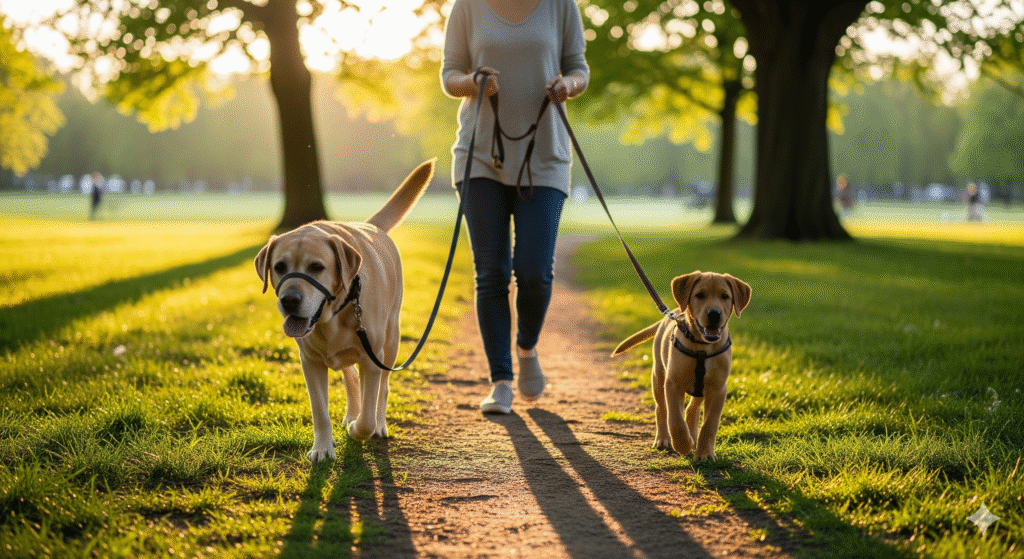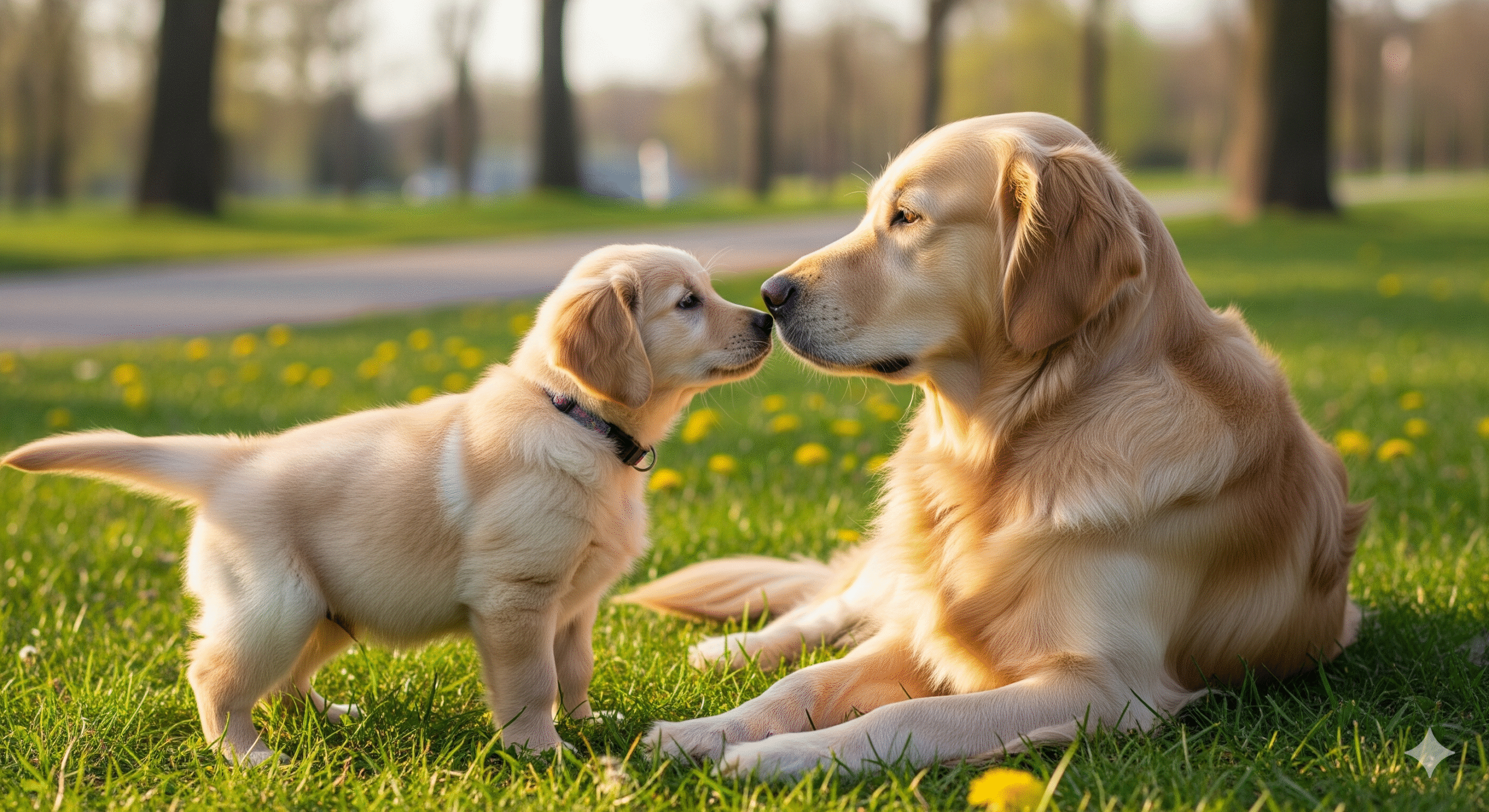Bringing a new puppy home is thrilling, but your resident dog may not share your enthusiasm. An older dog often views a bouncy, energetic puppy as an annoying intruder rather than a welcome friend. A poorly managed introduction can create lasting tension, jealousy, and even aggression. However, with a careful, patient strategy, you can foster a peaceful—and even playful—relationship between your old friend and your new family member.
This definitive guide will walk you through:
✔️ Pre-introduction preparation to set both dogs up for success
✔️ The ideal location for a first meeting (it’s not your home!)
✔️ A step-by-step introduction process from neutral ground to cohabitation
✔️ Reading canine body language to prevent conflicts
✔️ Managing the critical first weeks together
Let’s ensure your puppy’s homecoming is the beginning of a beautiful friendship.
Before You Begin: Preparation is Everything 🧰
Success depends on what you do before the dogs even see each other.
1. Health & Safety Check 🩺
- Veterinary Visit: Ensure both dogs are healthy, up-to-date on vaccinations, and parasite-free. Pain or illness in an older dog can make them unusually irritable.
- Grooming: Give both dogs a bath or grooming session so they smell neutral and pleasant.
2. Pre-Introduction Scent Swapping 👃
Dogs “see” with their noses. Introduce them through scent first.
- Days 1-3: Swap blankets or toys between the puppy and the older dog. Let each dog investigate the other’s scent in their own time, without pressure.
- Signs of Success: Your older dog sniffs the item curiously without growling or hackles raising. They may even seem interested.
3. Prepare Your Home 🏠
- Create Separate Zones: Use baby gates to section off the house. Your older dog needs safe, puppy-free spaces to retreat to.
- Remove Precious Resources: Pick up your older dog’s favorite toys, bones, and food bowls to prevent resource guarding.
- Set Up Separate Resources: Have duplicate food and water bowls, beds, and crates in different areas.
The Step-by-Step Introduction Process 🚶♂️🐕
Rushing this process is the biggest mistake you can make. Plan for this to take place over several hours or even days.
Step 1: The Neutral Territory Meeting 🌳
Never introduce dogs for the first time inside your home. Your home is your older dog’s territory, and a new puppy is an invader. Choose a neutral park or a friend’s yard.
- Walk the Dogs Separately: Have one person walk the older dog and another walk the puppy at a distance where they can see each other but are not close enough to interact.
- Parallel Walking: Walk the dogs parallel to each other, about 10-15 feet apart. Gradually decrease the distance as they become more comfortable. Reward both dogs with high-value treats for calm behavior.
- The First Sniff: Once the dogs seem relaxed (loose body language, no stiff tails), allow them to approach each other for a brief, 3-5 second sniff. Keep leashes loose but be ready to gently guide them apart.
- Keep it Short & Positive: End the interaction after a few positive sniffs. Do not let the puppy jump all over the older dog.
Step 2: Bringing the Puppy Home 🚪
- Bring the Older Dog Inside First: Let your resident dog enter the home first and settle down.
- Bring the Puppy In on Leash: Bring the puppy in on a loose leash. Keep the initial energy calm.
- Supervised Exploration: Allow the puppy to explore common areas on leash, with the older dog watching. Use baby gates to give the older dog an “out.”
- Separate When Unsupervised: For the first few weeks, never leave the puppy and older dog alone together. Use crates and baby gates.
Reading Canine Body Language: Green, Yellow, & Red Flags 🚦
Understanding what your dogs are saying is crucial to preventing a fight.
Green Flags: All Good! ✅
- Play Bow: Front end down, butt in the air.
- Loose, Wiggly Body: A relaxed, wiggly body with a softly wagging tail.
- Bouncy, Reciprocal Play: Taking turns chasing and being chased.
Yellow Flags: Proceed with Caution ⚠️
- Whale Eye: Showing the whites of their eyes.
- Lip Licking or Yawning: Signs of stress or anxiety.
- Stiff Body, Low Wagging Tail: The dog is unsure or on alert.
- The Older Dog Snapping or Growling: This is a clear warning to back off. Do not punish this; it’s a necessary communication.
Red Flags: Intervene Immediately! 🚨
- Raised Hackles: The hair on their back is standing up.
- Deep, Guttural Growling: Different from a warning grumble.
- Snarling with Teeth Fully Exposed: A clear threat.
- A Hard, Unblinking Stare: The dog is fixated and ready to attack.
To Intervene: Stay calm. Distract them with a loud noise (clap your hands, shake a treat can) and calmly lead them apart. Never get between two fighting dogs with your hands.
Managing the First Few Weeks: Setting House Rules 📝
The goal is peaceful coexistence, not forcing a best-friend relationship.
- Feed Separately: Always feed in separate rooms or crates to avoid food aggression.
- Favor the Older Dog: Give your older dog attention, treats, and affection first. This reassures them they are still top dog and prevents jealousy.
- Provide Plenty of “Puppy-Free” Time: Your older dog needs breaks. Enforce nap times for the puppy in their crate so the older dog can relax.
- Interrupt Rudeness: Gently interrupt the puppy if they are pestering the older dog (jumping, biting, constant barking). Redirect the puppy to a toy.
Common Challenges & Solutions 🛠️
Older Dog Growls at Puppy
- Solution: This is normal and appropriate. The older dog is teaching the puppy boundaries. Only intervene if it escalates beyond a warning.
Puppy Won’t Leave Older Dog Alone
- Solution: Enforce mandatory nap times for the puppy. Provide more mental stimulation (puzzle toys, training) to tire them out.
Dogs Ignore Each Other
- Solution: This is a perfect outcome! It means there is no conflict. Don’t force interaction; let their relationship develop naturally.
When to Seek Professional Help 🤝
Contact a certified professional dog trainer or behaviorist if:
- The older dog shows intense, uncontrolled aggression.
- Either dog injures the other.
- The level of stress does not decrease after several weeks.
Final Checklist for a Successful Introduction ✅
☑️ Health check complete for both dogs
☑️ Scent swapping done in advance
☑️ Home is prepared with separate zones
☑️ First meeting is on neutral territory
☑️ You can identify calming and stress signals
☑️ You have a plan for managing the first few weeks

“If your puppy is constantly scratching, chewing their paws, or suffering from recurrent ear infections, food allergies could be a potential culprit. Unlike environmental allergies, which may be seasonal, food allergies cause year-round symptoms. Identifying a food allergy requires a systematic elimination diet to pinpoint the exact trigger. For a complete guide on recognizing the signs and implementing a safe, vet-guided elimination diet, including alternative food options, read our resource on Puppy Food Allergies: Signs & Safe Alternatives.






